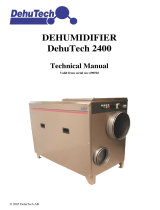Munters T-M160L-A1808 Owner's manual
- Category
- Dehumidifiers
- Type
- Owner's manual
Munters T-M160L-A1808 dehumidifier is designed to efficiently remove excess moisture from the air, creating a comfortable and healthy indoor environment. With its advanced technology, it offers precise humidity control, ensuring optimal conditions for various applications. Ideal for use in homes, offices, basements, and other spaces prone to moisture problems, it helps prevent mold, mildew, and other moisture-related issues.
Munters T-M160L-A1808 dehumidifier is designed to efficiently remove excess moisture from the air, creating a comfortable and healthy indoor environment. With its advanced technology, it offers precise humidity control, ensuring optimal conditions for various applications. Ideal for use in homes, offices, basements, and other spaces prone to moisture problems, it helps prevent mold, mildew, and other moisture-related issues.




















-
 1
1
-
 2
2
-
 3
3
-
 4
4
-
 5
5
-
 6
6
-
 7
7
-
 8
8
-
 9
9
-
 10
10
-
 11
11
-
 12
12
-
 13
13
-
 14
14
-
 15
15
-
 16
16
-
 17
17
-
 18
18
-
 19
19
-
 20
20
-
 21
21
-
 22
22
-
 23
23
-
 24
24
-
 25
25
-
 26
26
-
 27
27
-
 28
28
-
 29
29
-
 30
30
-
 31
31
-
 32
32
Munters T-M160L-A1808 Owner's manual
- Category
- Dehumidifiers
- Type
- Owner's manual
Munters T-M160L-A1808 dehumidifier is designed to efficiently remove excess moisture from the air, creating a comfortable and healthy indoor environment. With its advanced technology, it offers precise humidity control, ensuring optimal conditions for various applications. Ideal for use in homes, offices, basements, and other spaces prone to moisture problems, it helps prevent mold, mildew, and other moisture-related issues.
Ask a question and I''ll find the answer in the document
Finding information in a document is now easier with AI
Related papers
-
Munters T-M170L-A1808 Owner's manual
-
Munters T-M190Y-A1808 Owner's manual
-
Munters T-M210X-A1808 Owner's manual
-
Munters Weather Station 2 Owner's manual
-
Munters ComDry-M190Y Owner's manual
-
Munters QEN-CDCS-A1808 Owner's manual
-
Munters MEN-CDCS-A1808 Owner's manual
-
Munters 190TGB-1035-H1604 Owner's manual
-
Munters MG Owner's manual
-
Munters ComDry-M160L Owner's manual
Other documents
-
 Dehutech 2400 User manual
Dehutech 2400 User manual
-
Airthings 2900 Dimensions Guide
-
Aerial AD 20 Condensation Dehumidifier User manual
-
 Radon FTLab RD200 User guide
Radon FTLab RD200 User guide
-
Airthings 223 Radon Detector User guide
-
Meaco DD8L-ZAMBEZI User manual
-
RadonAway Radon-T Installation guide
-
 PRO-LAB RL116 Installation guide
PRO-LAB RL116 Installation guide
-
Meaco DD8L Zambezi User manual
-
LG MD16GQSA1 User guide


































